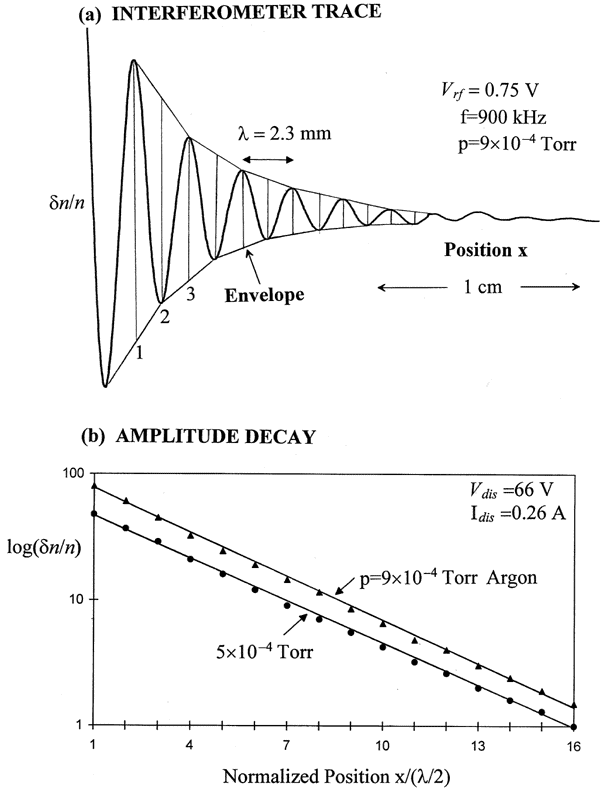Home|
Syllabus|
Notes|
Assignments
Spatial Damping of Ion Acoustic Waves
Plasma Physics Laboratory
R. L. Stenzel, Winter '97

Typical interferometer trace of a damped ion acoustic wave and its evaluation.
Here are some comments to the damping of ion acoustic waves:
- The damping manifests itself by the decay of the wave envelope
with distance x. The envelope can be approximated by connecting successive
maxima and minima as shown in the upper figure (a). In the lower
figure (b) the wave amplitude is displayed on a logarithmic scale
at every half wavelength. The straight-line approximation shows that the
amplitude varies as A(x)=A(0)exp(-x/Ldamping),
where Ldamping=2pi/kimaginary
is defined as the damping length. It is found to be
Ldamping ~18(lambda/2)/ln100=9.1 mm. The normalized
damping is defined by kimag/kreal.
Since the wavelength is related to the real part of the wavenumber,
lambda=2pi/kreal, one finds for
kimag/kreal =
(lambda/2pi)/Ldamping = ln100/18pi=0.081.
- There are several mechanisms giving rise to an amplitude
decay in the interferometer trace an ion acoustic wave. (1) If
it is not a plane wave there is an amplitude loss due to the
geometric spread of the wave (energy conservation). (2) Collisional
damping arises when the ion-neutral collision frequency is a significant
fraction of the wave frequency. (3) Landau damping arises when
particles move near the phase velocity of the wave and there are more slower
than faster particles, i.e., the slope of the distribution function
is negative at vphase. Both electrons and
ions produce Landau damping. Landau damping is strong when
the electron temperature is close to the ion temperature. Even at
high electron temperatures, ion Landau damping is strong near the
ion plasma frequency where the phase velocity decreases to the
ion thermal velocity. (4) Finally, if the wave is scattered by other
waves (e.g. in a turbulent plasma) the energy spread in frequency
gives rise to an energy loss at the injected signal frequency, hence
an amplitude decay in the interferometer trace.
- In order to distinguish among the various damping mechanisms
one can take certain precautions and perform a few basic tests. For
example, plane waves are produced close to a plane grid of dimensions
large compared to the wavelength. This holds for the present the
grid of 5cm diameter at a wavelength of 2.33 mm. Collisional damping
can be tested by varying the neutral pressure. The two traces
shown in (b) are taken at different neutral pressures but exhibit
nearly the same amplitude decay. Thus, the damping cannot be collisional.
Landau damping remains since the plasma is not turbulent.
- The theory of Landau damping (see Lab manual for a short version)
gives an expression for the normalized damping. In the present
case of low frequencies,
[(omega)/(omegapi)]2<<1,
it is given by Ldamping/(lambda) =
0.09 x-3/2 exp[x/2(1+3/x)], where
x=Te/Ti. For the measured
normalized damping length Ldamping/(lambda) =1.96
one finds numerically a temperature ratio x=10.1. With an
electron temperature of kTe=1.78 eV, obtained from
the phase velocity, one obtains an ion temperature of
kTi=0.15 eV.
Thus, ion acoustic wave measurements are a useful diagnostics for obtaining both
electron and ion temperatures.
Home|
Syllabus|
Notes|
Assignments
Page maintained by
R. L. Stenzel and/or
J. M. Urrutia
Copyright © 1997, The Regents of the University of California. All Rights Reserved.
Last Update: 5 March 1997


